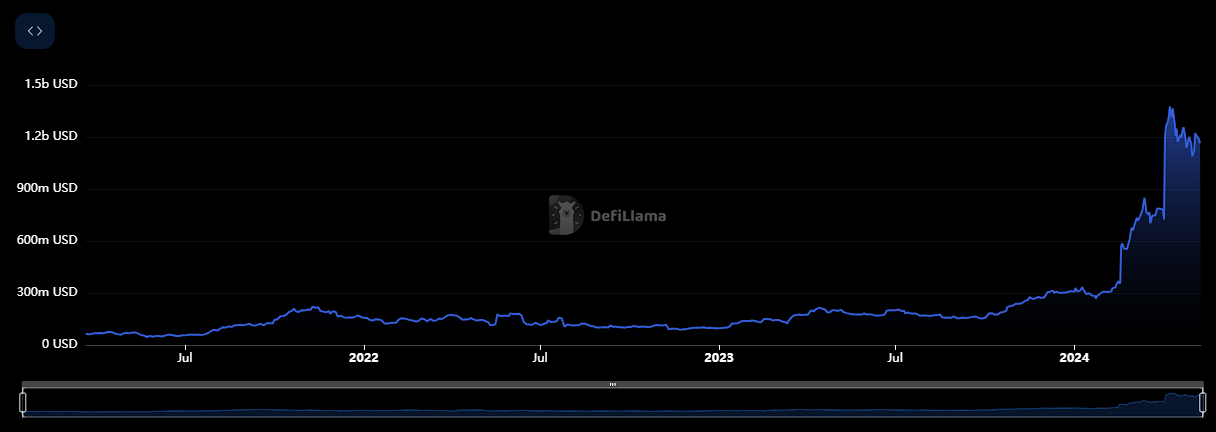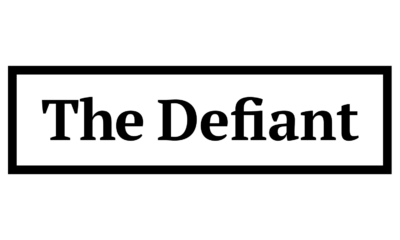DeFi
Institutions are likely to be interested in Bitcoin DeFi applications

Last updated: May 10, 2024, 5:01 p.m. EDT | 6 minutes of reading

Bitcoin (BTC) is evolving rapidly. Although the Bitcoin network has been primarily used for payment transactions, current activity appears to resemble that of Ethereum during the height of decentralized application (Dapp) projects.
The introduction of Bitcoin Runes and BRC-20 tokens – which emerged at the time of fourth Bitcoin halvedt – likely sparked the evolution of Bitcoin’s native decentralized finance (DeFi).
The emergence of Bitcoin DeFi
Rena Shah, VP of Product at Trust Machines – a team focused on growing the Bitcoin economy – told Cryptonews that two years ago, Bitcoin DeFi was not a narrative the ecosystem was discussing.
However, Shah noted that the emergence of staking platforms and lending protocols on the Bitcoin network have sparked investor interest in transitioning assets from a store of value to a source of value.
The growth of the Bitcoin DeFi (BTCFI) ecosystem is astounding 🧡
🟧 @ALEXLabBTC leading the charge, with @Bitflow_Finance & @StackingDao following.
– Data from @signal21btc pic.twitter.com/87MP5hMCbL
– stacks.btc (@Stacks) May 8, 2024
“The desire to move from a passive Bitcoin asset to a productive asset is real in 2024,” she said. “We are building this future because we can see that Bitcoin DeFi attracts not only retail investors but also institutional investors.”
Institutions will show interest in Bitcoin DeFi
Data from DeFiLlama watch that the total value locked (TVL) of Bitcoin is approximately $1.2 billion. Yet, according to Shah, nearly $1 trillion in capital is locked on the Bitcoin blockchain.
“Even the smallest percentages of capital that become productive in DeFi will make huge waves in the Bitcoin ecosystem,” Shah emphasized.
This, along with the recent approval of Spot Bitcoin exchange-traded funds (ETFs) in the United States, increases the potential of Bitcoin DeFi applications. In particular, this will likely appeal to Bitcoin-holding institutions and retail investors.

Tycho Onnasch, the co-founder of Zest Protocol, told Cryptonews that he believes BTC is a more institutional asset than the rest of crypto.
“Therefore, I expect institutions to play a larger role in using and starting Bitcoin DeFi,” Onnasch said.
Bitcoin DeFi Apps for Institutions
Although Bitcoin DeFi is still a relatively new concept, a number of projects aim to enable and advance the sector.
For example, Onnasch explained that Zest Protocol is creating a lending protocol specifically for Bitcoin. He mentioned that the aim of the platform is to create permissionless financial infrastructure for BTC lending markets.
“Zest allows users to collateralize BTC to borrow other tokens such as stablecoins,” he said. “The platform also allows users to earn yield on their BTC.”
Indeed, the primary use case for Bitcoin DeFi applications appears to be to ensure that Bitcoin becomes a more productive asset for investors.
Dr. Chiente Hsu, co-founder of ALEX and XLink, told Cryptonews that Alex is a new financial layer for the Bitcoin network.
“Our goal is to seamlessly integrate Bitcoin with Layer 2 (L2) solutions and the Ethereum Virtual Machine (EVM) world,” Hsu said. “This will allow us to grow the Bitcoin economy,” Hsu said.
For example, Hsu explained that investors can earn a return on their BTC by connecting a Bitcoin Wallet to XLink. He noted that XLink is powered by ALEX’s Automated Market Maker (AMM) and Decentralized Exchange (DEX). This will enable cross-chain exchanges between Bitcoin L2 and the EVM world.
“Bitcoin DeFi for institutions will be looking for Bitcoin yield generating assets,” Hsu said.
Hsu believes this is likely to be the case due to the amount of capital present on the Bitcoin network.
“There is well over $1 trillion of Bitcoin capital that is ‘idle’ in the sense that its value rises and falls relative to the Bitcoin spot price,” he said. “But unlike Ethereum, Bitcoin cannot be natively locked to generate yield. This is a solution that ALEX is actively pursuing, which will allow institutions holding Bitcoin to earn a return on their Bitcoin capital.
Bitcoin DeFi resembles its Ethereum counterparts
Another interesting point is that even though Bitcoin DeFi is unique, applications tend to look like DeFi projects on Ethereum (ETH). This is important to consider as institutions have started to show interest in many current DeFi applications.
Digital asset management company Fireblocks have recently seen increased institutional DeFi activity on the Fireblocks platform. According to the firm, there was a 75% jump in the first quarter of 2024.
Fireblocks reported that some of the most popular Dapps that institutional clients interact with when trading, lending, staking, and bridging include Uniswap, Aave, Curve, 1inch, and Jupiter.
Jeff Yin, CEO of Merlin Chain – a Bitcoin L2 facilitating fast and profitable transactions with support for BTC Dapps – told Cryptonews that DEXs, derivatives and lending are all areas where BTC has learned a lot from lending. ‘ETH. He added that many new protocols are emerging.
“For example, “Surf” is a derivatives trading protocol launched on Merlin Chain and now boasts a daily trading volume of over $10 million. These are similar to their Ethereum counterparts,” Yin said.
Yin explained that a specific Bitcoin DeFi application would replicate one of the largest ETH DeFi Protocols, Lido – which holds $28 billion and represents half of Ethereum’s DeFi TVL.
“SolvBTC is currently developing an underlying BTC yield protocol,” Yin said. “Additionally, Unicross has implemented a Rune trading protocol on a BTC L2, allowing users to trade layer 1 (L1) assets at a lower cost on L2. These represent the most innovative aspects of the sector.
Bitcoin DeFi Could Overtake Ethereum
Although Bitcoin DeFi may resemble Ethereum, Shah believes that decentralized finance using BTC could eventually surpass Ethereum.
“Look DappRadar, Ethereum has over 600 active applications with varying volume and activity,” Shah said. “I have no reason to expect that Bitcoin DeFi cannot match Ethereum, and eventually replace it with Dapps in the ecosystem.”
Some solutions also make it easier to introduce Ethereum Dapps on Bitcoin.
Zack Voell, director of marketing at Botanix Labs, told Cryptonews that Botanix has created a “Spiderchain” that easily enables DeFi on Bitcoin.
“Spiderchain creates a fully EVM-equivalent environment for Dapps and smart contracts on Ethereum to be copy-pasted to run natively on Bitcoin,” Voell said. “Botanix Labs is building the Spiderchain to combine the two most Lindy technologies in crypto – EVM and Bitcoin – instead of trying to reinvent a whole new protocol or virtual machine.”
Challenges can slow adoption
Although it is too early to determine the fate of Bitcoin DeFi, there are some challenges that could slow its adoption.
For example, Yin pointed out that liquidity fragmentation often results from the difficulty of implementing DeFi on an L1 network. This in turn forces most activities to disperse through various L2 solutionsbut Yin noted that this could make it difficult to concentrate liquidity.
“One potential solution could be to create omnichain liquidity, similar to the Stone protocol in the Ethereum ecosystem,” he said. “We look forward to future implementations such as M-STONEBTC and Solv Protocol that could unify BTC L2 liquidity.”
Furthermore, Shah mentioned that the challenge of Bitcoin is to keep the base layer secure, stable and unaltered.
“This is where scaling becomes critical,” she said. “A healthy and diverse L2 ecosystem will be what ultimately allows Bitcoin DeFi, as a vertical, to succeed.”
Shah added that programming environments on Bitcoin are inherently difficult because many developers in other ecosystems are less familiar with Bitcoin scripting.
She stressed that one way to combat this phenomenon is to create WebAssembly (WASM) or different runtime environments like Rust, Solidity and Cosmos with L2.
“This approach will likely help attract new developers to the ecosystem,” she noted.
DeFi
Haust Network Partners with Gateway to Connect to AggLayer

Dubai, United Arab Emirates, August 1, 2024, Chainwire
Consumer adoption of cryptocurrencies is a snowball that is accelerating by the day. More and more people around the world are clamoring for access to DeFi. However, the user interface and user experience of cryptocurrencies still lag behind their fundamental utility, and users lack the simple and secure access they need to truly on-chain products.
Haust Network is a network and suite of products focused on changing this paradigm and bringing DeFi to the masses. To achieve this goal, Haust Network has announced its far-reaching partnership with bridgeseasoned veterans in rapidly delivering revolutionary blockchain utilities for projects. The Gateway team empowers blockchain developers to build DAOs, NFT platforms, payment services, and more. They drive adoption of crypto primitives for individuals and institutions around the world by helping everyone build their on-chain presence.
Gateway specializes in connecting sovereign blockchains to the Aggregation Layer (AggLayer). The AggLayer is a single unified contract that powers the Ethereum bridge of many disparate blockchains, allowing them all to connect to a single unified liquidity pool. The AggLayer abstracts away the complexities of cross-chain DeFi, making tedious multi-chain transactions as easy for the end user as a single click. It’s all about creating access to DeFi, and with Polygon’s technology and the help of Gateways, Haust is doing just that.
As part of their partnership, Gateway will build an advanced zkEVM blockchain for Haust Network, leveraging its extensive experience to deploy ultra-fast sovereign applications with unmatched security, and enabling Haust Network to deliver its products to its audience.
The recently announced launch of the Haust Wallet is a Telegram mini-app that provides users with access to DeFi directly through the Telegram interface. Users who deposit funds into the wallet will have access to all standard send/receive services and generate an automatic yield on their funds. The yield is generated by Haust Network’s interconnected network of smart contracts, Haustoria, which provides automated and passive DeFi yielding.
As part of this partnership, the Haust Network development team will work closely with Gateway developers to launch Haust Network. Gateway is an implementation provider for Polygon CDK and zkEVM technology, which the Haust wallet will leverage to deliver advanced DeFi tools directly to the wallet users’ fingertips. Haust’s partnership with Gateway comes shortly after the announcement of a high-profile alliance with the Polygon community. Together, the three will work to build Haust Network and connect its products to the AggLayer.
About Haust Network
Haust Network is an application-based absolute liquidity network and will be built to be compatible with the Ethereum Virtual Machine (EVM). Haust aims to provide native yield to all users’ assets. In Telegram’s Haust Wallet, users can spend and collect their cryptocurrencies in one easy place, at the same time. Haust operates its network of self-balancing smart contracts that interact across multiple blockchains and then efficiently funnel what has been generated to Haust users.
About Gateway
bridge is a leading white-label blockchain provider that offers no-code protocol deployment. Users can launch custom blockchains in just ten minutes. They are an implementation provider for Polygon CDK and have already helped projects like Wirex, Gnosis Pay, and PalmNFT bring new utility to the crypto landscape.
About Polygon Labs
Polygon Laboratories Polygon Labs is a software development company building and developing a network of aggregated blockchains via the AggLayer, secured by Ethereum. As a public infrastructure, the AggLayer will aggregate the user bases and liquidity of any connected chain, and leverage Ethereum as the settlement layer. Polygon Labs has also contributed to the core development of several widely adopted scaling protocols and tools for launching blockchains, including Polygon PoS, Polygon zkEVM, and Polygon Miden, which is currently under development, as well as the Polygon CDK.
Contact
Lana Kovalski
haustnetwork@gmail.com
DeFi
Ethena downplays danger of letting traders use USDe to back risky bets – DL News

- Ethena and ByBit will allow derivatives traders to use USDe as collateral.
- There is a risk in letting traders use an asset partially backed by derivatives to place more bets.
Ethena has downplayed the dangers of a new feature, which will allow traders to put up its synthetic dollar USDe as collateral when trading derivatives, which are risky bets on the prices of crypto assets.
While allowing users to underwrite their trades with yield-bearing USDe is an attractive prospect, Ethena said there is potential risk in letting traders use an asset partially backed by derivatives to place even more derivatives bets.
“We have taken this risk into account and that is why Ethena operates across more than five different sites,” said Conor Ryder, head of research at Ethena Labs. DL News.
The move comes as competition in the stablecoin sector intensifies.
In recent weeks, PayPal grown up the amount of its stablecoin PYUSD in circulation 96%, while the MakerDAO cooperative plans a rebrandingaiming to increase the supply of its DAI stablecoin to 100 billion.
US dollar growth stagnates
It comes as Ethena has lost momentum after its blockbuster launch in December.
In early July, USDe reached a record level of 3.6 billion in circulation.
That figure has now fallen by 11% to around 3.2 billion.
Join the community to receive our latest stories and updates
New uses for USDe could boost demand for Ethena’s products.
This is where the new plan, announcement Tuesday with ByBit, one of its partner exchanges, is coming.
Ethena users create USDe by depositing Bitcoin or Ether into the protocol.
Ethena then covers these deposits with short positions – bearish bets – on the corresponding asset.
This creates a stable support for USDe, unaffected by price fluctuations in Bitcoin or Ether.
Mitigate risks
While using USDe as collateral for derivatives trading is proving popular, it is unclear what the effects will be if the cryptocurrency market experiences major fluctuations.
Using derivatives as collateral to place more bets has already had disastrous effects.
In June 2022, Lido’s liquid staking token stETH broke its peg to Ether following the fallout from the Terra collapse.
Many traders who used looping leverage to increase their stETH staking yields were liquidated, creating a cascade that caused the price of Ether to drop by more than 43%.
Ethena Labs founder Guy Young said: DL News His office and his partners have taken many precautions.
Ethena spreads bearish bets supporting the USDe across the five exchanges it partners with.
According to Ethena, 48% of short positions supporting USDe are on Binance, 23% on ByBit, 20% on OKX, 5% on Deribit, and 1% on Bitget. website.
In doing so, Ethena aims to minimize the impact of an unforeseen event on a stock market.
The same theory applies to the distribution of risks across different supporting assets.
Fifty percent of USDe is backed by Bitcoin, 30% by Ether, 11% by Ether liquid staking tokens, and 8% by Tether’s USDT stablecoin.
Previous reviews
Ethena has already been criticised regarding the risks associated with USDe.
Some have compared USDe to TerraUSD, an undercollateralized stablecoin that collapsed in 2022.
“It’s not a good design for long-term stability,” said Austin Campbell, an assistant professor at Columbia Business School. said as the USDe launch approaches.
Young replied to critics, saying the industry needs to be more diligent and careful when “marketing products to users who might not understand them as well as we do.”
Ethena has since added a disclaimer on its website stating that USDe is not the same as a fiat stablecoin like USDC or USDT.
“This means that the risks involved are inherently different,” the project says on its website.
Tim Craig is DL News DeFi correspondent based in Edinburgh. Feel free to share your tips with us at tim@dlnews.com.
DeFi
Cryptocurrency and defi firms lost $266 million to hackers in July

In July 2024, the cryptocurrency industry suffered a series of devastating attacks, resulting in losses amounting to approximately $266 million.
Blockchain Research Firm Peck Shield revealed in an X post On August 1, attacks on decentralized protocols in July reached $266 million, a 51% increase from $176 million reported in June.
The most significant breach last month involved WazirX, one of India’s largest cryptocurrency exchanges, which lost $230 million in what appears to be a highly sophisticated attack by North Korean hackers. The attack was a major blow to the stock market, leading to a break in withdrawals. Subsequently, WazirX launched a program in order to recover the funds.
Another notable incident involved Compound Finance, a decentralized lending protocol, which suffered a governance attack by a group known as the “Golden Boys,” who passed a proposal who allocated 499,000 COMP tokens – valued at $24 million – to a vault under their control.
The cross-chain liquidity aggregation protocol LI.FI also fell victim On July 16, a hack resulted in losses of $9.73 million. Additionally, Bittensor, a decentralized machine learning network, was one of the first protocols to suffer an exploit last month, loming $8 million on July 3 due to an attack targeting its staking mechanism.
Meanwhile, Rho Markets, a lending protocol, suffered a $7.6 million breach. However, in an interesting twist, the exploiters research to return the stolen funds, claiming the incident was not a hack.
July 31, reports The Terra blockchain protocol was also hacked, resulting in a loss of $6.8 million across multiple cryptocurrencies. As crypto.news reported, the attack exploited a reentrancy vulnerability that had been identified a few months ago.
Dough Finance, a liquidity protocol, lost $1.8 million in Ethereum (ETH) and USD Coin (USDC) to a flash loan attack on July 12. Similarly, Minterest, a lending and borrowing protocol, saw a loss of $1.4 million due to exchange rate manipulation in one of its markets.
Decentralized staking platform MonoSwap also reported a loss of $1.3 million following an attack that allowed the perpetrators to withdraw the liquidity staked on the protocol. Finally, Delta Prime, another decentralized finance platform, suffered a $1 million breach, although $900,000 of the stolen funds was later recovered.
DeFi
The Rise of Bitcoin DeFi: Then and Now

The convergence of Bitcoin’s robust security and Layer 2 scaling solutions has catalyzed the emergence of a vibrant DeFi ecosystem.
By expanding Bitcoin’s utility beyond simple peer-to-peer payments, these advancements have opened up a new frontier of financial possibilities, allowing users to participate in decentralized lending, trading, and other complex smart contract operations on Bitcoin.
Read on to learn about the rise of Bitcoin-based decentralized finance and how the space has expanded to accommodate a new generation of native assets and features.
Note: If you want to learn candlesticks and chart trading from scratch, this is the best book available on Amazon! Get the book now!
What is DeFi?
Decentralized finance (DeFi) represents a paradigm shift in financial services, offering internet-based financial products such as trading, lending, and borrowing through the use of decentralized public blockchains.
By implementing blockchains, smart contracts, and digital assets, DeFi protocols provide financial services through a decentralized ecosystem, where participants do not have to deal with intermediaries when transacting.
What is Bitcoin DeFi?
The inherent limitations of the Bitcoin mainchain in supporting the intricacies of decentralized finance have created the need to develop smart contract-based Layer 2 solutions.
Additionally, the advent of the Ordinals protocol in 2023, which facilitated the emergence of fungible token standards such as BRC-20 and Runes, catalyzed the growth of DeFi on the Bitcoin blockchain.
This expansion in protocol diversity has broadened the applications of the world’s leading cryptocurrency network beyond the core base-layer use cases around value preservation and transactional capabilities.
Therefore, Bitcoin DeFi has become a nascent sector within the digital asset market, after previously being a missing essential part of the Bitcoin ecosystem.
Bitcoin DeFi in its early days
Integrating decentralized finance (DeFi) concepts into the Bitcoin ecosystem has been a journey of innovation and perseverance. Early attempts to bridge the gap between Bitcoin’s fundamental simplicity and DeFi’s complexities have spawned pioneering projects that, while laying essential foundations, have also encountered significant obstacles.
Colored coins
Colored coins represented an early foray into tokenizing real-world assets on the Bitcoin blockchain. By leveraging the existing network to track ownership of assets ranging from stocks to real estate, this approach highlighted Bitcoin’s potential as a platform beyond digital currency. However, scalability and practical implementation challenges have limited its widespread adoption.
Counterpart
Building on the colored coins, Counterparty has become a platform for creating and trading digital assets, including non-fungible tokens (NFTs), on Bitcoin.
The introduction of popular projects like Rare Pepe NFTs has demonstrated the growing appeal of digital collectibles. However, constraints around user experience and network efficiency have hampered its full potential.
These early experiments, while not fully realizing their ambitions, served as valuable stepping stones, informing Bitcoin DeFi’s subsequent developments. Their challenges highlighted the need for more sophisticated infrastructure and protocols to harness the full potential of decentralized finance on the Bitcoin network.
Bitcoin DeFi Today
Today, building DeFi applications on Bitcoin is primarily done in the realm of Layer 2 (L2) networks. This architectural choice is motivated by the limitations of Bitcoin’s base layer in supporting complex programmable smart contracts.
Bitcoin’s original design prioritized security and decentralization over programmability, making it difficult to develop sophisticated DeFi protocols directly on its blockchain. However, the recent emergence of protocols like Ordinals, BRC-20, and Runes, while not DeFi in their own right, has sparked possibilities for future DeFi-like applications on the main chain.
In contrast, L2 solutions offer a scalable and programmable environment built on Bitcoin, enabling the creation of various DeFi products.
By expanding Bitcoin’s capabilities without compromising its core principles, L2s have become the preferred platform for developers looking to build DeFi applications that encompass trading, lending, staking, and more.
Leading L2 networks such as Lightning Network, Rootstock, Stacks, and Build on Bitcoin provide the infrastructure for these efforts. Some of these L2s have even introduced their own native tokens to the network, further expanding Bitcoin’s DeFi ecosystem.
Essentially, while Bitcoin’s core layer presents challenges for DeFi development, its security and decentralization have provided a foundational layer for the innovative L2 landscape to thrive.
Bitcoin Layer 2 offers a promising path to building a robust and thriving Bitcoin-based DeFi ecosystem that offers trading, staking, lending, and borrowing. All you need is a DeFi Wallet like Xverse to access the new world of decentralized financial services secured by Bitcoin.
Conclusion
The integration of DeFi principles into the Bitcoin ecosystem, primarily facilitated by Layer 2 solutions, marks a significant evolution in the digital asset landscape.
Building on the foundational work of pioneers like Colored Coins and Counterparty, the industry has evolved into more sophisticated platforms like Rootstock, Stacks, and Build on Bitcoin to create a thriving Bitcoin-powered DeFi ecosystem.
Advertisement
-

 News11 months ago
News11 months agoBitcoin soars above $63,000 as money flows into new US investment products
-

 DeFi11 months ago
DeFi11 months agoEthena downplays danger of letting traders use USDe to back risky bets – DL News
-

 News11 months ago
News11 months agoFRA Strengthens Cryptocurrency Practice with New Director Thomas Hyun
-

 DeFi11 months ago
DeFi11 months agoZodialtd.com to revolutionize derivatives trading with WEB3 technology
-

 Markets11 months ago
Markets11 months agoBitcoin Fails to Recover from Dovish FOMC Meeting: Why?
-

 DeFi1 year ago
DeFi1 year ago👀 Lido prepares its response to the recovery boom
-

 DeFi1 year ago
DeFi1 year agoPancakeSwap integrates Zyfi for transparent, gas-free DeFi
-

 DeFi1 year ago
DeFi1 year ago🏴☠️ Pump.Fun operated by Insider Exploit
-

 Markets1 year ago
Markets1 year agoa resilient industry that defies market turbulence
-

 DeFi1 year ago
DeFi1 year ago👀SEC Receives Updated Spot Ether ETF Filings
-

 DeFi1 year ago
DeFi1 year ago🚀 S&P says tokenization is the future
-

 DeFi1 year ago
DeFi1 year ago⏱️ The SEC is not rushing the commercialization of Spot Ether ETFs







